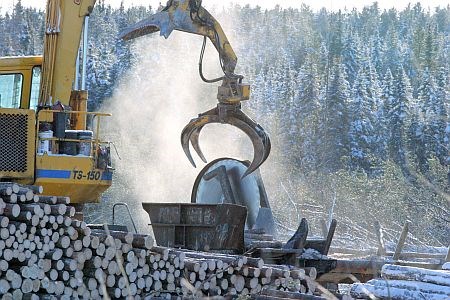Being off the beaten path – two hours North of the Trans-Canada Highway in northwestern Ontario – has traditionally been a weakness for the Municipality of Red Lake, but that's changing.
Two major infrastructure projects are now underway, one of which takes
advantage of the town's unique access to the province's vast and largely
untapped boreal forest.
Federal finance minister Jim Flaherty was in town
Aug. 5 to announce $2.3 million in stimulus funding for an 200-hectare
industrial park during his tour of Ontario's northwest.
“It's certainly
our largest venture into the industrial zoning of a park,” says Red Lake Mayor
Phil Vinet. “This is big.”
Located near the Red Lake Airport, the
Nungesser Road Industrial Park will dedicate half its space to housing a
prefabricated chalet-building operations run by Two Feathers Forest Products .
The other half will offer space for more than 40 other tenants, filling up as
the town grows.
“There's been plenty of inquiries from many industrial
people,” says Bill Greenway, economic development officer for Red
Lake.
“We don't have an inventory right now. All of our industrial
property is pretty much taken.”
Scheduled to occupy the park by late
2010, the Two Feathers plant represents a rare increase in forestry jobs, an
industry that's been characterized in recent years by plant closures and job
loss.
The logs come from the Whitefeather Forest at Pikangikum, a First
Nation located 100 kilometres northwest of Red Lake. They will be shipped to the
Red Lake plant, which is a sawmilling and kiln drying plant. The wood products
will then be trucked south to the Eagle Lake First Nation for prefabricated
chalet construction.
“We're no different than any other town when it
comes to forest products,” says Vinet. “We lost probably 300 jobs.”
“But we
fully expect to at least get those 300 back.”
Although the backbone of the town is still mining, Vinet says he can see
a day when Red Lake is a leader in forestry and mining in the
northwest.
“I can see down the road when Red Lake will be a leader in
value-added wood products.”
The industrial park is only
one of two major developments currently underway in the town. Nearly 20
kilometres to the south of the industrial park, a large commercial development on
the southern end of town is underway.
Located on Highway 105, the development will provide 18 hectares of space for
restaurants, big box stores and other retail outlets. Occupancy will start in
the spring or summer of 2010.
The town is the entry point to Woodland Caribou Provincial Park.
"It's fairly new in the tourism game," says Vinet. The town's motto is now "Gateway to Woodland Caribou Provincial Park."
However, Red Lake's
tourism trade has been hard-hit this year, in line with what many northern towns
experienced.
With tourism struggling, the town has relied on gold advanced gold exploration and continued mining to carry itself through the economic downturn.
With an economy that's traditionally been solely based on gold, Red Lake
residents are used to the boom and bust cycle.
Like similar Northern Ontario gold mining areas, such as Kirkland Lake or Timmins, the
local economy is in an upswing from recent high gold prices.
“There's a
significant amount of exploration going on for gold,” says Vinet. “That's a
pretty nice economic generator.”




